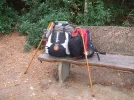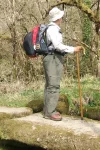fcsklabrie said:
This may be a very basic question - as I haven't used my new trekking poles yet - but are there technical advantages to using trekking poles vs wooden poles/staff?
thank you!
Yes, there are technical advantages, but they come when you use the pole's design features effectively. Pete's pole page has been mentioned earlier in this thread, and is a good place to start learning how to use the poles to best advantage.
First, you need to learn to wear the wrist strap so that (1) you can lean on the pole without gripping the hand grip, (2) have the pole naturally return to your hand when you plant the end on the ground, and (3) when you raise your arm, the pole hangs clearly below your wrist and doesn't interfere with you gripping other objects, eg a map, compass, camera etc. There are only two ways to wear the wrist strap - one achieves all three of these, the other doesn't. Set up this way, the force on the pole comes from the strap around your wrist, and does not depend on your ability to grip the hand grip time and time again at each step you take.
Second, the length of the pole will determine the balance between how much weight you take of your lower limbs, and how much propulsion you will achieve. The longer the pole, the more propulsion. If you want to take weight off your lower limb joints, shorten the pole length. I find that the minimum length is when it is just long enough to reach the ground when my upper arm is beside my torso, and my lower arm is at right angles, roughly parallel to the ground.
Third, consider whether you need to wear a pair of fingerless gloves to prevent blisters. I have a pair with chamois lining, rubber finger and palm pads and an elasticised fabric on the back.
Once you are set up, you can use your poles all day, every day for weeks on end. This is the key advantage - a wooden staff has to be grasped each time you place the end down - and over the course of the day, your ability to do this will decline. A properly worn technical pole doesn't rely on your grip, and you only have to guide the end into place, not grasp the handle as well. You will get much the same effect with a technical pole across the whole day, not just while you are fresh.
In difficult terrain, there are also advantages because of this. Going downhill (lengthen the pole first) a technical pole can take far more of your weight because you don't have to grip it, giving both greater stability on difficult surfaces, or a faster descent if the surface is good. Similarly, going uphill, where you may not need the pole as a stability aid, it can bring your upper body into play to assist in the climb.
Finally, if you get the wrist strap right, you can keep wearing a technical pole when you are doing simple tasks with your hands, and won't have to put the pole down. It will just hang below your wrist or forearm while you do something else with your hands, and with a minor adjustment or two, you can start walking with the pole again. More complex manual tasks will still require you to remove the pole.
I keep repeating the secret of good trekking pole use is as simple as getting the wrist strap right. Its because there are only two ways to put your hand through the strap, but I see so few people who have trekking poles actually get it right. If you don't, your pole is just an expensive aluminium alloy staff with a fancy handle, and you won't be getting best value from your equipment.
Regards,



















